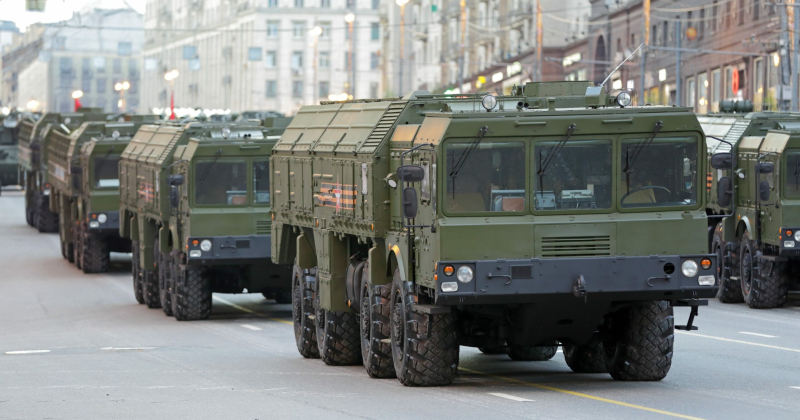Since the beginning of a full-scale war, Russia has been actively shelling Ukrainian cities with missile systems and weapons of various types. Among them there is an operational-tactical complex Iskander.
ICTV Facts has collected information about these Iskander heavy missile systems.
Iskander — what is this
OTRK Iskander is a family of complexes: Iskander, Iskander-M, Iskander-K, Iskander-E. They are the development of the Mechanical Engineering Design Bureau in the city of Kolomna, Moscow region.
Now watching
The first Iskander was presented in August 1999. Its main purpose is the destruction of enemy air defense (air defense) and missile defense (missile defense) systems, as well as important objects (bridges, warehouses) at a distance of up to 500 km.
In general, Iskanders are considered more powerful weapons than, for example, Caliber, and can potentially carry nuclear warheads.
The complexes use super-maneuverable ballistic missiles with stealth technologies, as well as decoy targets to bypass missile defense systems.
Iskander — damage range
These operational-tactical missile systems can use both cruise and quasi-ballistic missiles.
The latter are distinguished from conventional ballistic missiles by their shorter range — from 500 to 1 thousand km, which allows their use in regional conflicts.
It is worth noting that the mass of the rocket is 3.8 tons, the warhead is 480 kg, the length of the rocket is 7.2 m, and the diameter is 920 mm. Maximum trajectory height — 50 km. Minimum engagement range – 50 km.
The Russian Army is armed with the Iskander-M, a complex with two 9M723 quasi-ballistic missiles.
Earlier, The New York Times wrote, citing American intelligence, that the ballistic missiles of the Iskander-M complexes, which Russia fired into Ukraine, have decoys capable of deceiving air defense radars and thermal search missiles.
So, each of the devices is approximately 30 cm in length, shaped like a white cylinder with an orange tail.
The decoy is stuffed with electronics and emits radio signals that can jam enemy radars that are trying to find the Iskander-M. The decoy also contains a heat source to attract incoming missiles.
It is worth noting that it is the Iskanders in Russia that are called the main weapon of deterrence against NATO.
Use of Iskanders in Ukraine
It was probably from Iskanders that strikes were carried out on Ukrainian airfields at the very beginning of the invasion on February 24, 2022, and the airport in Zhitomir was attacked on February 27, 2022.
According to reports from the Ukrainian military leadership, the Russian army used Iskander missiles in the shelling of Kyiv and other cities in Ukraine. For example, on the night of March 2-3, Kyiv was shelled by P-500 (9M728) missiles from the Iskander complex.
On March 9, a ballistic missile from the Iskander complex was launched in the direction of Kramatorsk. The missile was shot down by Ukrainian air defense.
On March 14, Russian troops launched strikes on residential areas of Kharkov, including with Iskander missile systems, and on the morning of May 27, a cruise missile from this system was launched from the Rostov region and hit the barracks of the National Guard of Ukraine in the Dnepropetrovsk region.
The Iskanders fired at the Dnieper, Kharkov, and Slavyansk. And on September 16, 2022, the Air Defense units of the East in the Dnipropetrovsk region destroyed three cruise missiles Iskander-K.
< p > also the enemy used the Iskander during a day attack on Kyiv on May 29, 2023. < p > < p > on the night of June 1, 2023, the troops of the Russian Federation made another attack on Kyiv, applying ten winged and ballistic missiles such as Iskander, they were all destroyed. also a missile Iskander in the city Pervomaisky Army of the Russian Federation inflicted on July 4, 2023. During the shelling, 43 people were injured, 12 of which are children.
< p > July 28, 2023 Russia, preliminary, < b >~ 60 > two missiles Iskander attacked a high -rise building in the Dnieper. In addition to a residential building, the building of the Ukrainian Security Service was also damaged. In addition, as a result of the blow there are victims.
On October 5, 2023, Russian troops struck a shop-cafe in the village of Groza in the Kharkiv region with an Iskander missile. The attack killed 51 people.
On the morning of October 6, 2023, Russian troops launched two strikes on Kharkiv. The strike killed a 10-year-old boy. There are also 25 known wounded.
After the Russian attack on Kyiv on January 2, when a high-rise building was damaged, debris was found that is an analogue of the Russian Iskander-M, which has a 500 kg warhead and flies up to 450 km.
On February 7, 2024, 3 missiles were launched from the Iskander-M OTRK in the direction of the Kharkiv region.
On February 15, 2024, 6 Iskander-M and KN-23 missiles were launched in the direction of the northern and eastern regions (1 was shot down).
On February 17, 2024, 1 missile was launched from the Iskander-M OTRK in the direction of Zaporizhia.
On February 14, 2024 and February 18, 2024, 1 missile was launched from the Iskander-M OTRK in the direction of Donetsk region.
On February 16, 2024, 3 Iskander-M/KN-23 missiles were launched in the direction of Poltava and Kirovograd regions.
On February 19, 2024, 1 missile was launched from the Iskander-M/KN-23 OTRK in the direction of Kirovograd region.
On April 17, 2024, in the morning, the Russians launched a missile attack on Chernihiv. According to the head of the Chernihiv Regional State Administration Vyacheslav Chaus, the enemy hit the city with three Iskander missiles.
On April 25, 2024, Russian troops attacked the railway station in Balakleya, Kharkiv Oblast, with an Iskander-M missile with a fragmentation warhead that exploded in the air.
On April 29, 2024, Russian troops hit Odessa with an Iskander ballistic missile with a cluster warhead. As a result of the attack, five people were killed and more than 30 were injured.

